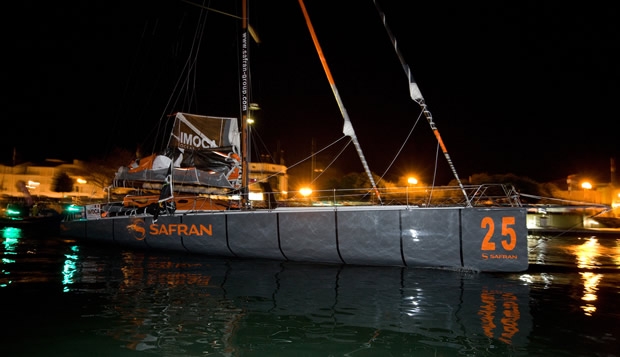
Safran retires
At 1645 UTC yesterday Marc Guillemot, skipper of Safran, called his shore team to inform them that he had hit something and that there had been a loud bang, after which the boat suddenly heeled over. After making the boat safe, he decided to head back to Les Sables d’Olonne in order to inspect the damage.
Safran arrived in Les Sables this morning (Sunday) at 0100 UTC. His shore team immediately examined the boat and saw that the keel had broken off under the waterline.
As they do not have a spare keel, Safran is unable to set off again in the race.
Metallurgical tests will be carried out on the keel head in order to determine the causes of the damage.
The Safran group has been alongside Marc Guillemot for seven years and fully supports him at this difficult time.
At a press conference subsequently, Guillmot said that at the time of the incident they had been close reaching but with big gusts and shifts of up to 40°, that required constant trimming of both sails and ballast.
"Suddenly there were two successive bangs in the space of about one second," said Guillemot. "I did not feel it was under the hull, but it was very loud and around the keel. The boat heeled dangerously. The fact that I had the sheets more or less in my hand meant I could dump the main and headsail quickly."
He added that he didn't look at the keel immediately because he instinctively went through all the emergency things - rolling up the jib, and dropping the main to the third reef. Thankfully the water ballast was already in the forward and middle tanks so Safran was stable. He then turned the bows for Les Sables d'Olonne.
"I still don’t know at this time if I hit something or not," Guillemot continued. "If it was not a collision, it might be a case of metal fatigue, a design thing or calculation thing it is hard to know. But it is certain that being 50 miles from Les Sables d’Olonne it was relatively safe as the fleet was still quite tightly bunched. It is better than being in 35 knots of wind south of the Kerguelens for example.
"But I am disappointed for our sponsor and for the team also. At the moment I am in the phase of trying to find out and understand what happened."
According to Guillemot, Safran's unique titanium keel foil had between 23,000 and 25,000 miles on the clock. "We trained with it before last year's Transat Jacques Vabre, then we did the Transat B2B, went around the British Isles, and then 4-5,000 miles in conditions which were not always easy. So, given all it had been through, I left confident with it. No competitor would consider leaving without a lot of confidence in their keel."
On Monday morning, Safran will be towed to her base at La Trinité-sur-Mer, where she will be taken out of the water.














Latest Comments
Graeme 13/11/2012 - 00:04
An IMOCA 60 has a maximum draft of 4.5 metres. A blank for a keel fin is likely to be somewhere around 5 metres long, 1 metre wide, and (being lazy) 0.2 metre thick. As a rough order of magnitude estimate, that comes out as a cubic metre. According to Wolfram Alpha, a cubic metre of titanium weighs 9960 lbs and costs $67K, €52K or £42K. I suspect machining will be hideously expensive for anyone who doesn't have an aerospace supplier as a sponsor.rxe281 12/11/2012 - 21:50
I read there was only a five inch stub left - will be interesting to see what the cause was - two bangs says to me one for the initial fatigue failure as it finally bent / fractured the second as it became completely detached / snapped off. Real shame as this was clearly a boat pushing the technical boundaries and a great skipper.James Boyd 12/11/2012 - 15:06
Anyone got a view on how much a titanium keel foil like Safran's would cost (assuming you weren't fortunate enough to have a sizable ingot of it hanging around, as they did....) Cost of titanium is around US$10/lbAdd a comment - Members log in